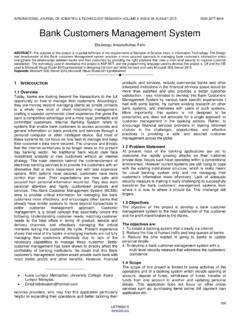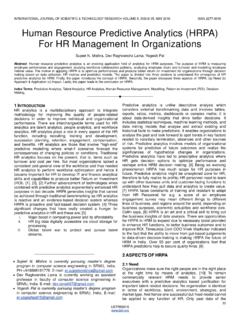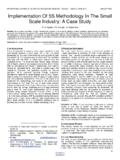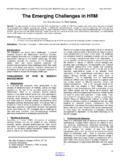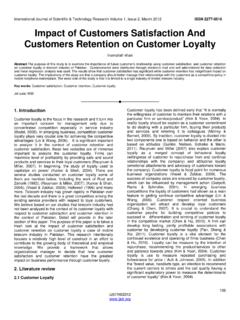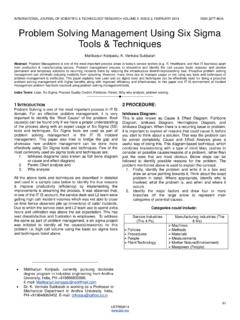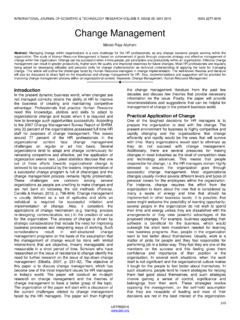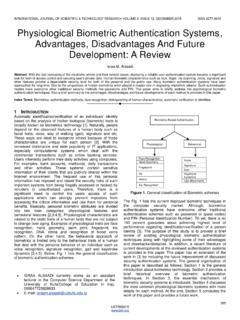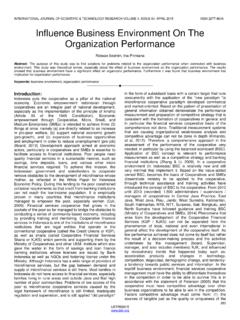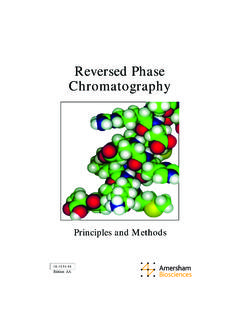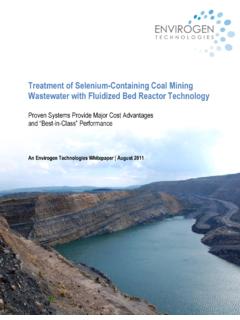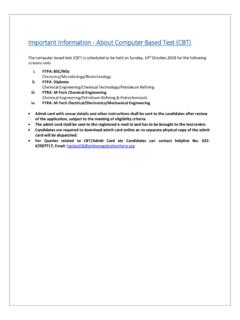Transcription of Adsorption of Xylene on Granular Activated Carbon in a ...
1 International Journal of Scientific & Technology Research Volume 1, Issue 3, May 2012 ISSN 2277-8616 90 IJSTR 2012 Adsorption of Xylene on Granular Activated Carbon in a Packed Bed Kaushal Naresh Gupta*, Nandagiri Jagannatha Rao, Govind Kumar Agarwal Abstract- The primary objective was to experimentally determine the performance of Granular Activated Carbon in effectively adsorbing volatile organic compounds from inert gaseous stream under varying operating conditions. Experiments were carried out to study Adsorption of Xylene a volatile organic compound (VOC) on the Granular Activated Carbon . The experiments were carried out in a fixed bed Adsorption column under various operating conditions.
2 The range of experimental variables is as follows: inlet gas concentration (2400 6200 ppm), gas flow rate (50 ml/min) and height of the adsorbent bed ( m). The breakthrough curves were then drawn between ratios of outlet gas concentration to inlet gas concentration versus time for different operating conditions. Index Terms: Adsorption , Breakthrough Curve, Granular Activated Carbon , VOCs, Xylene 1. INTRODUCTION Rapid economic development and urban population growth have triggered a series of challenges to the endeavors of maintaining the clean air. Urban air quality is cause of public concern, largely as a result of instances of smog and health problems.
3 New pollutants are being increasingly recognized. Air pollution sources have grown and so also the pollutants. Some of these have led to emission of some hazardous air pollutants like volatile organic compounds. Volatile Organic Compounds (VOCs) are chemicals that evaporate easily at room temperature they have high enough vapor pressure under normal conditions to significantly vaporize and enter the atmosphere. They are characterized by a very high vapor pressure, exceeding kPa at 25 C [1]. VOCs are aliphatic and aromatic hydrocarbons, which may contain hetro-atoms, like oxygen, sulphur, nitrogen, halogens. A wide range of Carbon based molecules such as aldehydes, ketones, hydrocarbons etc are VOCs.
4 Volatile organic compounds are contributors to the formation of ozone and other photochemical oxidants leading to urban smog. Many VOCs have been identified as toxic, carcinogenic or mutagenic at concentrations levels found in urban environment [2]. VOC exposures are often associated with an odor while at other times there is no odor. Both can be harmful. Emissions of VOCs originate from breathing and loading losses from storage tanks, venting of process vessels, leaks from piping and equipment [3].There are thousands of different VOCs produced and used in our daily lives. For Benzene, Toluene, Methylene chloride, Formaldehyde, Xylene , Ethylene glycol, 1,3-Butadiene etc.
5 Approximately 235 million tons of VOCs are released per year into the atmosphere by man-made sources [4]. The subject has become important because of the impact on environment and human. Recommended strategies for reducing organic vapors include product substitution or reformulation, thermal or catalytic incineration and Activated Carbon Adsorption (followed by regeneration of the adsorbent and VOC and VOC recovery or catalytic incineration of the highly concentrated stream) [5]. *Corresponding Author: Kaushal Naresh Gupta, Senior Lecturer, Department of Chemical Engineering, Jaypee University of Engineering & Technology, Road, Raghogarh, Guna-473226, Madhya Pradesh, India, Email: Fax: +91-7544-267011, Contact No.
6 : +91-7544-267051, Ext. No.: 141 The removal of volatile organic compounds commonly performed by Adsorption is of great interest for the air quality control. At a low-concentration level, Adsorption on active Carbon is the most employed method for the removal of VOCs [6].The need is an Adsorption process is to have a porous solid medium providing high Adsorption capacity. A large surface area or large micro-pore volume can be achieved due to the porous structure of the solid. The breakthrough curve is reflective of the adsorbents performance under dynamic conditions. A relatively larger breakthrough time and gradual increase in the concentration following breakthrough are desirable.
7 One of the main issues is the concentration measurement of VOC in a gas-vapor mixture. Das et al. [7] assumed gas to be saturated after being passed through the column filled with the VOC liquid. Some researchers [8-9] also assumed the exit gas to be saturated with VOC at the concentration corresponding to the temperature of the bubbler. Lordgooei et al. [10] passed nitrogen gas through two fritted glass bubblers connected in series containing VOC liquid and immersed in a temperature-controlled water bath and then the exit nitrogen gas from the second bubbler was assumed to be saturated with VOC corresponding to the temperature of the bubbler. Asnin et al. [11] also prepared a gas-vapor mixture by the passage of nitrogen through a saturator containing chlorobenzene at 0 C and then the exit gas was assumed to be saturated.
8 Hence by reviewing the literature it has been found that in most of the studies carried so far on the Adsorption of VOCs the concentration of VOC in the gas-vapor mixture was found by assuming it as saturated gas after being passed through VOC liquid. In such techniques it is always debatable whether the vapor-gas mixture is saturated or not. In the present study the technique used for measuring the concentration of VOC in a gas-vapor mixture was by drawing a calibration curve obtained from the saturated gas-vapor mixture prepared separately in a gas collector at a particular fixed temperature. The major objectives of this study were as follows: (1) set-up of an experimental test bench to study the Adsorption phenomena for the removal of VOCs by commercially available GAC.
9 (2) Obtain breakthrough curves under varying operating conditions such as inlet concentrations, gas flow rate and height of the adsorbent bed. 2. EXPERIMENTAL STUDIES The experiments were carried on Granular Activated Carbon (density 400 kg/m3) particles of diameter m. The other International Journal of Scientific & Technology Research Volume 1, Issue 3, May 2012 ISSN 2277-8616 91 IJSTR 2012 physical properties of Activated Carbon are listed in Table 1. The several operating conditions under which the Adsorption experiments were carried out were inlet concentration of VOC, gas flow rate and adsorbent bed height. Table 2 describes these conditions.
10 Table 1: Physical properties of Activated Carbon Table 2: Range of experimental variables Experimental Set- up Figure 1 is the schematic of the experimental set-up designed and used for carrying out Adsorption experiments. The set-up consists of three sections: a gas preparation section, an Adsorption section, and an analytical section. In the gas preparation section, carrier gas (nitrogen in this case) is bubbled in the liquid VOC ( Xylene ) contained in a vertical glass column ( m long and m diameter). Isothermal conditions are maintained in the column by circulating water at a fixed temperature around the column. The bubbler is a SS of mm diameter tube whose bottom end is closed and the outer surface is perforated with a hole of diameter mm near the bottom and nitrogen is bubbled in the Xylene liquid through the hole.
